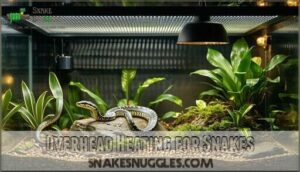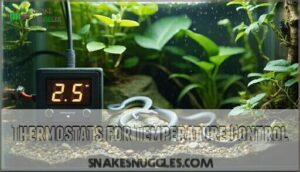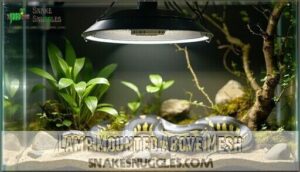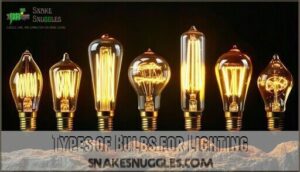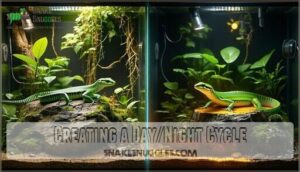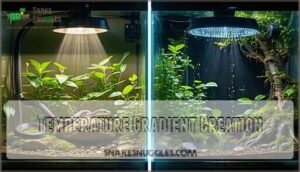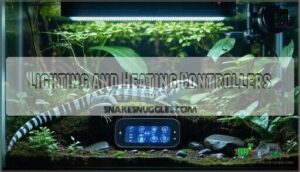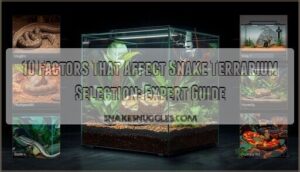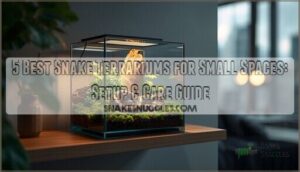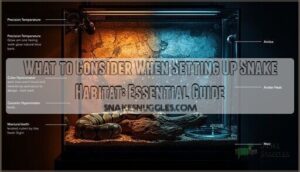This site is supported by our readers. We may earn a commission, at no cost to you, if you purchase through links.
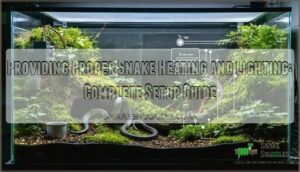 Providing proper snake heating and lighting means creating a temperature gradient between 75-95°F using heat mats, ceramic emitters, or overhead bulbs, paired with a 12-hour day/night lighting cycle.
Providing proper snake heating and lighting means creating a temperature gradient between 75-95°F using heat mats, ceramic emitters, or overhead bulbs, paired with a 12-hour day/night lighting cycle.
You’ll need thermostats to prevent dangerous overheating and digital thermometers to monitor both warm and cool zones. Since snakes can’t regulate their own body temperature, they depend on you to create distinct thermal zones – think of it as giving them their own personal climate control system.
Different species have varying needs: ball pythons crave consistent warmth and higher humidity, while corn snakes tolerate cooler temperatures.
The secret lies in understanding that your snake will naturally move between warmer basking spots and cooler retreat areas to maintain ideal body function, making proper gradient setup absolutely critical for their health and survival.
Table Of Contents
- Key Takeaways
- Snake Heating Options
- Snake Lighting Needs
- Temperature Gradient Creation
- Humidity Levels for Snakes
- Lighting and Heating Controllers
- Frequently Asked Questions (FAQs)
- What is the best way to heat a snake?
- What kind of lighting does a snake need?
- Should I leave my snakes heat lamp on at night?
- What is the best heating method for snakes?
- What is the best heating and lighting for a ball python?
- Is it safe to leave a reptile heat lamp on all day?
- What should my snakes heating pad be at?
- How often should I replace my snakes heating equipment?
- Can snakes see color or only shades of gray?
- Do albino snakes require different lighting considerations?
- Conclusion
Key Takeaways
- You’ll need to create a temperature gradient of 75-95°F using heat mats, ceramic emitters, or overhead bulbs with thermostats to prevent dangerous overheating and allow your snake to thermoregulate naturally.
- You must establish distinct thermal zones with a warm basking spot at one end and a cooler retreat area at the opposite side, spanning at least two-thirds of your enclosure length.
- You should maintain species-specific humidity levels (ball pythons need 50-60%, corn snakes need 40-60%) and provide a 12-hour day/night lighting cycle to support natural circadian rhythms.
- You’ll want to avoid heat rocks entirely due to burn risks and use digital thermometers with hygrometers for continuous monitoring of both temperature and humidity levels throughout the enclosure.
Snake Heating Options
Choosing the right heating system determines your snake’s health and comfort throughout its life. You’ll find three main options that work effectively: heat mats, heat rocks, and overhead heating systems.
Heat Mats for Snakes
Heat mats for snakes provide consistent, gentle warmth from below, mimicking natural basking surfaces. You’ll want proper mat placement underneath one-third of your enclosure’s floor.
Choose appropriate wattage selection based on tank size—typically 8-15 watts per square foot. Address safety concerns with thermostats preventing overheating.
Quality snake heating elements offer 3-5 year lifespan expectations with proper care. Many owners find that under tank mats work best.
Verify substrate compatibility by avoiding thick bedding that blocks heat transfer.
Heat Rocks for Snakes
While heat mats provide gentle warmth, you’ll want to steer clear of heat rocks for your snake.
Heat rock dangers include severe burns from malfunctioning thermostats and uneven heating. These devices can’t provide proper snake heating since they only warm the surface without penetrating deeper tissues.
Heat rocks: where "gentle warmth" meets third-degree burns—skip these dangerous relics entirely.
Rock temperature control often fails, creating dangerous hot spots. Instead, consider alternative heat sources like reptile heating lamps for safer snake enclosure heating.
Reptiles also have limited ability to sense gradual temperature increases, which can lead to burns.
Overhead Heating for Snakes
Overhead reptile heating lamps create essential basking spots that mimic natural sunlight for your snake.
These systems provide infrared benefits while supporting natural basking behavior, making them ideal for naturalistic setups that meet specific species needs.
Many keepers find suitable reptile heat lamps through online retailers.
- Heat lamp safety: Mount fixtures securely above mesh tops to prevent burns and guarantee proper ventilation
- Snake lighting systems: Choose ceramic heat emitters or halogen bulbs for consistent warmth without disrupting sleep cycles
- Proper snake heating: Position lamps to create focused warm zones that encourage natural thermoregulation
- Snake tank lighting: Combine with UVB bulbs for species requiring additional spectrum benefits
Thermostats for Temperature Control
Why risk your snake’s health with temperature swings?
Thermostats are your safety net, maintaining precise temperatures through probe placement and accurate readings.
Digital models offer superior calibration methods and safety features compared to basic analog versions.
Position probes at basking spots, not against glass surfaces.
Quality thermostats prevent overheating disasters while supporting your complete snake lighting systems and habitat requirements.
Snake Lighting Needs
Proper lighting plays a vital role in your snake’s health, affecting their natural behaviors and circadian rhythms.
You’ll need to understand different bulb types and create appropriate day/night cycles to keep your serpent thriving, which involves complete concepts of lighting to ensure the well-being of your pet.
Lamp Mounted Above Mesh
Your snake’s lamp placement affects both heating efficiency and safety.
Position fixtures 6-12 inches above screen tops to prevent burn prevention while maintaining proper lamp distance.
Mesh heat reduction occurs naturally, but UVB penetration remains adequate for most reptile heat sources.
Secure fixture safety by checking mounting brackets regularly, ensuring your snake habitat lighting stays stable and effective.
Types of Bulbs for Lighting
Selecting proper reptile heat sources involves understanding how different bulb types affect your snake’s environment.
Each option offers unique benefits for snake habitat lighting:
- Incandescent bulbs provide heat emission and broad color spectrum but lack UVB output
- LED options offer exceptional bulb lifespan (25,000+ hours) with minimal energy waste
- Fluorescent tubes deliver UVB bulbs for diurnal species requiring ultraviolet exposure
- Mercury vapor bulbs combine heat, light, and UVB in single fixtures for complete lighting
To find the right product, consider snake UVB options.
Understanding snake lighting requirements helps you choose appropriate reptile lighting options for ideal habitat conditions.
Creating a Day/Night Cycle
Twelve-hour lighting schedules work best for most snake species year-round.
Timer settings should provide consistent light schedules with gradual phases at dawn and dusk to minimize stress.
Seasonal adjustments aren’t necessary for indoor snakes, but maintaining regular cycles supports natural behavioral impacts.
Quality reptile lighting options with automated controls guarantee your snake lighting requirements stay consistent without daily intervention.
Proper lighting is also essential for vitamin D3 synthesis and overall health, and it supports natural behavioral impacts through consistent light schedules and regular cycles.
Red Lights for Snakes
Red lights won’t disturb your snake’s circadian rhythm like white lights do at night.
However, snake vision can detect red wavelengths better than previously thought, making these lights less ideal than complete darkness.
Here are five key considerations for red lighting:
- Light pollution – Even red lights can disrupt natural behavioral patterns
- Alternative heating – Ceramic heat emitters provide warmth without visible light
- Behavioral effects – Constant illumination may stress nocturnal species
- Snake heat sources – Infrared panels offer targeted warming zones
- Reptile heat lamps – Choose non-light-emitting options for nighttime use
Temperature Gradient Creation
Creating the right temperature gradient is essential for your snake’s health and natural behaviors.
You’ll need to establish a warm basking spot on one side and a cooler retreat area on the other, allowing your snake to thermoregulate by moving between zones as needed.
Choosing The Right Heat Source
Heat source safety depends on your snake species needs and enclosure size considerations.
Ball pythons require different heat lamps for reptiles than corn snakes. Consider energy efficiency and long-term costs when selecting snake heat sources.
Ceramic heat emitters offer consistent snake tank heat without light disruption. Under-tank heaters work well for smaller enclosures, while reptile heat lamps suit larger setups requiring overhead warmth.
A consistent heat source is essential for digestion.
Setting Up a Gradient
Creating a proper thermal environment requires strategic placement of your heating elements. You’ll establish a basking spot at one end and a cool zone at the opposite side, allowing your snake to thermoregulate naturally.
- Position your primary heat source at one end to create the basking spot (88-92°F for most species)
- Leave the opposite end unheated to form the cool zone (75-80°F)
- Place temperature monitoring devices at both ends to track gradient effectiveness
- Ensure gradient size spans at least two-thirds of your enclosure length
- Research your species needs since ball pythons require different ranges than corn snakes
Selecting Heat Mats or Heat Rocks
When choosing between heat sources, you’ll find heat mat safety consistently outranks heat rocks.
Rock temperature consistency proves unreliable, with documented burn rates reaching 76%.
Species-specific needs matter—terrestrial snakes like ball pythons thrive with substrate heating, while burrowing considerations favor gentle under-tank warmth.
Cost comparison shows heat mats use less electricity and require fewer legal replacements due to equipment failure.
Using Thermostats and Hygrometers
Most snake keepers discover that proper thermostat calibration and hygrometer placement are game-changers for maintaining accurate readings.
Digital controller types with safety features prevent overheating disasters that could harm your snake.
Position hygrometers away from water bowls for precise humidity monitoring.
Quality thermostats aren’t just heating for reptiles—they’re your snake’s life insurance policy, ensuring consistent temperatures without constant babysitting.
Humidity Levels for Snakes
You’ll need to maintain proper humidity levels to keep your snake healthy and support essential processes like shedding.
Different species require specific humidity ranges, and you can create microclimates within the enclosure to meet these needs effectively.
Humidity for Corn Snakes
Maintaining ideal humidity levels for your corn snake isn’t rocket science, but getting it wrong can spell trouble.
These hardy serpents thrive when you keep their environment between 40-60% relative humidity.
Too dry, and you’ll face shedding problems; too wet invites respiratory infections.
- Shedding Humidity: Bump levels to 70% during shed cycles for smooth skin removal
- Proper Misting: Light daily spraying maintains consistent moisture without oversaturating substrate choice
- Hydration Methods: Wide water bowls increase evaporation while providing drinking access
- Substrate Choice: Cypress mulch retains moisture better than aspen shavings for stable levels
- Respiratory Infections: Avoid chronic dampness above 70% that promotes harmful bacterial growth
Monitor with digital hygrometers placed at both warm and cool ends.
Humidity for Ball Pythons
Ball pythons require 50-60% humidity for ideal health, though shedding humidity should reach 70-80% temporarily.
Poor substrate choice and inadequate misting techniques often cause respiratory infections or dehydration.
Monitor levels carefully using digital hygrometers to prevent health issues.
| Humidity Level | Purpose | Duration |
|---|---|---|
| 50-60% | Daily maintenance | Continuous |
| 70-80% | Shedding cycles | 3-5 days |
| Below 40% | Avoid completely | Never |
| Above 80% | Risk zone | Avoid |
| 40-50% | Emergency minimum | Short-term only |
Creating Microclimates
Your snake’s terrarium becomes a miniature ecosystem when you strategically create distinct microclimates.
Different zones within the enclosure allow your pet to thermoregulate naturally, just like in the wild.
- Basking Spot humidity – Keep the warm side slightly drier (40-50%) to prevent respiratory issues
- Cool Zone moisture – Maintain higher humidity (60-70%) using damp substrate moisture or water bowls
- Species Needs variation – Research your snake’s natural habitat to match enclosure size requirements and lighting for snakes preferences
Monitoring Humidity With Hygrometers
Accurate humidity monitoring requires proper hygrometer calibration using the salt test method.
Digital hygrometers offer better precision than analog models for species-specific needs.
Place multiple hygrometers at different heights – warm and cool sides – since humidity varies throughout your enclosure.
Set humidity alarms to alert you when levels drift outside your snake’s ideal range, preventing health issues before they develop, which is crucial for maintaining the right environment and ensuring the well-being of your snake.
Lighting and Heating Controllers
Managing your snake’s environment becomes effortless when you use automated controllers that maintain consistent conditions around the clock.
These devices eliminate the guesswork by precisely regulating temperature, lighting cycles, and humidity levels without constant manual adjustments, making it easier to provide a stable environment for your snake with automated controllers.
Timers for Lighting and Heating
Setting proper timing schedules helps maintain your snake’s circadian rhythms and prevents overheating risks.
Digital timers offer superior Timer Reliability compared to mechanical alternatives, ensuring consistent Automated Schedules for your reptile tank lighting needs.
Consider these timer essentials:
- Programmable digital timers – Enable precise Sunrise/Sunset Simulation with multiple daily switching cycles
- Heavy-duty models – Handle high-wattage heating elements without electrical failure concerns
- Strategic Timer Placement – Position away from moisture sources to prevent malfunction
Quality snake lighting solutions incorporate Energy Savings through automated cycling, reducing electricity costs while maintaining ideal photoperiods for your pet’s health.
Automatic Controllers for Snakes
Digital reptile thermostats maintain precise temperatures within 50–122°F ranges, preventing dangerous fluctuations.
Advanced programming features include Controller Calibration for accuracy, Safety Features like overheat alarms, and Remote Monitoring via smartphone apps.
These controllers offer Advanced Programming with day/night cycles and Backup Systems that preserve settings during power outages, ensuring your snake’s environment stays stable around the clock.
Reptile owners find that using these devices provides precise temperature control for their pet’s habitats, allowing for stable environments and advanced programming with features like remote monitoring.
Hygrometers for Humidity Control
Beyond basic monitoring, hygrometer calibration guarantees accuracy when species-specific humidity requirements matter most.
Digital models offer precise readings, while analog versions provide reliable backup monitoring.
Strategic placement near your snake’s preferred basking spots captures localized humidity variations.
Advanced units feature humidity alarms, alerting you when levels drift outside acceptable ranges for your particular species.
Frequently Asked Questions (FAQs)
What is the best way to heat a snake?
Like a warm rock under desert sun, you’ll need to create a "heat gradient" by heating one end of the cage.
But leaving the other unheated, allowing your snake to self-regulate temperature naturally.
What kind of lighting does a snake need?
You’ll need different lighting based on your snake species. Nocturnal snakes require minimal UVB, while diurnal species benefit from UVB lighting for vitamin D3 synthesis and natural behaviors.
Should I leave my snakes heat lamp on at night?
Most nocturnal species don’t require heat lamps at night—ironically, darkness helps regulate their natural circadian rhythms.
You’ll want ceramic heat emitters or under-tank heaters instead, maintaining proper thermal gradients without disrupting sleep cycles.
What is the best heating method for snakes?
Ceramic heat emitters provide consistent, infrared warmth without disrupting natural day-night cycles, making them ideal for most snake species. You’ll want thermostats controlling temperatures between species-specific ranges.
What is the best heating and lighting for a ball python?
Picture your ball python basking like a sunbather on a tropical beach.
You’ll need ceramic heat emitters or radiant heat panels for ambient warmth, under-tank heaters for belly heat, and UVB lighting for ideal health and natural behaviors.
Is it safe to leave a reptile heat lamp on all day?
Yes, you can safely leave most reptile heat lamps on continuously.
Ceramic heat emitters and radiant heat panels work 24/7 without issues.
However, basking bulbs that produce visible light should follow day/night cycles to maintain your pet’s natural circadian rhythms.
What should my snakes heating pad be at?
Properly positioning your python’s pad provides perfect temperature control.
Set your heating pad to 88-92°F for most species, creating a thermal gradient.
You’ll want the warm side at this temperature while the cool side stays around 78-80°F for ideal thermoregulation.
How often should I replace my snakes heating equipment?
Replace heating equipment every 2-3 years for maximum safety and performance. Check heating pads, ceramic heaters, and thermostats annually for wear, cracks, or malfunctions that could harm your snake.
Can snakes see color or only shades of gray?
Contrary to popular belief, snakes don’t see just black and white.
Most species possess dichromatic vision, detecting blues and greens effectively.
Some pythons and boas even have specialized heat-sensing pits that "see" infrared radiation, creating thermal images.
Do albino snakes require different lighting considerations?
Albino snakes need reduced UV exposure since they lack protective melanin pigmentation.
You’ll want dimmer lighting and should avoid bright UVB bulbs that could damage their sensitive eyes and skin, causing burns or discomfort, particularly to prevent discomfort.
Conclusion
Mastering providing proper snake heating and lighting transforms your terrarium from a simple enclosure into a thriving habitat that mirrors your snake’s natural environment.
You’ve learned that temperature gradients, species-specific humidity requirements, and proper lighting cycles work together as an integrated system.
Your snake’s health depends on consistent monitoring with thermostats and hygrometers, preventing dangerous temperature fluctuations.
Remember, different species have unique needs—ball pythons require higher humidity than corn snakes, and success comes from patience and attention to detail in your setup.
- https://success.bcgsearch.com/big-law-breakthrough-step1
- https://us02web.zoom.us/webinar/register/1816134981508/WN_yjkrJZPURHGblJOlQLCNjg
- http://www.harrisonbarnes.com/
- https://dubiaroaches.com/blogs/reptiles/why-you-shouldn-t-buy-a-heat-rock-for-your-reptile
- https://zamzows.com/blogs/pets-animals/the-pros-and-cons-of-heat-rocks



